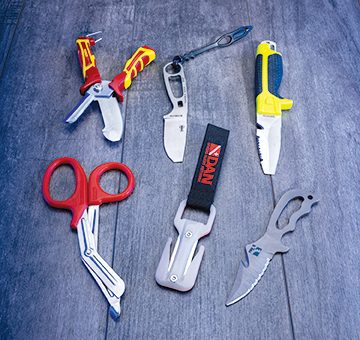THE DIVE KNIFE IS AN ICONIC PART OF A SCUBA DIVER’S GEAR. Since the inception of diving as a recreational activity, the dive knife’s presence in a diver’s equipment has influenced the public image of scuba diving as a dangerous sport and placed its participants in a league of their own. Imagine how the perception of golf or table tennis would change if its players strapped 12-inch blades to their thighs for personal safety.
It was the perfect symbol for early divers — brave and adventurous thrill seekers who lived on the razor’s edge, plunging into the depths of an unknown underwater world. For decades divers embraced the fearless image that the dive knife helped convey.
As more divers entered the water over generations and became environmentally aware of their surroundings and limitations, fantasies of underwater combat with enemy divers or predatory sharks gave way to the more realistic dangers for recreational divers, such as entanglements.
EXperience-Driven Innovation
In its early days, diving was not fully commercialized, lacking both specialty gear and its distributors. The first dive knives came from what was already widely available. Kitchen knives, military surplus knives such as the leather-wrapped Ka-Bar, and wooden or cork floating boat knives were popular choices for divers to repurpose.
As the industry began marketing stainless steel knives with rubber handles and sheaths for divers, the knives followed both the size trend of their military predecessors and the adventurous and dangerous image associated with them. Some knives had fierce-looking but impractical trench-knife-style D-guards, while others had heavy hammer-style pommels on the hilt for pounding and breaking off artifacts from shipwrecks.
Over time the dive knife evolved into a safety tool, with the appearance of line cutters embedded in the length of the blade and serrated edges opposite the standard straight edge for underwater sawing applications. For practicality, blades gradually shortened in length and thickness to reduce size and weight and increase wieldability. The addition of blunt tips to reduce the chance of accidental injury or damage to equipment became the most recognizable element of what now distinguishes a dive knife from other knives.
As dive knives trended toward safety and practical applications, cutting devices began entering the recreational diving market, having been repurposed from their original uses by the military, public safety, and technical diving communities. It is now common to see recreational divers choosing standalone mini line cutters, trauma shears, scissor knives, or folding pocketknives instead of the fixed-blade knives that reigned supreme for decades.


Safe Practices
As big dive knives declined in popularity, so did the common placement of knives on the outside of the thigh or calf. These placements have caused snags, caught ditched weight belts, and were hard to reach or required excessive movement to access.
Today divers place their knives and cutting devices in the buoyancy compensator pocket, waist strap, shoulder strap, inflator hose, or on their forearm. The waist belt provides equal access by both hands and allows the diver to quickly confirm its presence visually. Shoulder strap and inflator hose placements also allow quick access by being near where a diver is likely to keep their hands at rest.
Retention mechanisms include Velcro, push-to-release, squeeze lock, and fitted retention molds. Select a retention method that stays secure. Be comfortable with its placement on you or your gear, ensuring that you can retrieve and replace it from its stowed position without fumbling around or injuring yourself.
Before diving with your selected tool, understand its capabilities and limitations by testing it before you need to rely on it. Don’t hope it works — make sure it works. Like all scuba gear, dive knives and cutting implements need cleaning and maintenance to ensure functionality. Depending on your type of diving, you may use your cutting device only in an emergency, which is not the time to discover it has rusted shut or adhered to its sheath.
However you wear it, make sure your cutting device doesn’t get in the way of your hoses or other equipment, that you can access it quickly, and that it’s reachable even if one arm is restricted, entangled, or occupied.
When it comes to using cutting tools underwater, you are the biggest hazard to your own safety. Mitigate your risk by being deliberate with your actions and practicing cutting skills like you would a regulator recovery or any other crucial skill.
The Right Tool for the Job
Before you enter the water, consider the hazards you may encounter. The environment and your dive plan will determine if you should bring a cutting device, a dive knife, or both. Recreational divers in high-traffic areas will be primarily concerned with discarded fishing line and equipment, whereas public safety divers will focus on what they can use safely in zero-visibility environments rife with potential entanglement hazards. Spearfishers may prefer a stiletto-style pointed-tip knife for quickly dispatching fish, while divers who penetrate wrecks will want heavy-duty wire cutters capable of cutting dangling metal cables or electrical wires.
For some divers, big knives are souvenirs from the past, representing the wild frontier of early scuba diving. For others, large dive knives remain relevant and preferable for tasks such as probing in sand or silt, establishing a fixed position for circular search patterns, pounding stuck boat anchors, and cutting rope from propeller shafts. There have been instances in which divers became entangled and a small cutting device was insufficient for self-rescue, such as when a diver became enveloped in a submerged wool blanket while diving in a local river.
Whatever you choose to bring on your dive, both dive knives and cutting devices remain essential safety tools to have as part of your gear. You may never need to use them, but only one dangerous encounter at depth will make you to wish you had one. Keep in mind that no piece of gear is a suitable replacement for skill development, self-awareness, and emotional self-control when facing adverse situations underwater. AD
© Alert Diver — Q3 2023